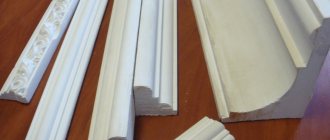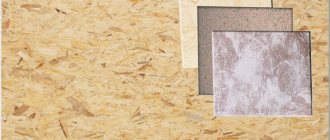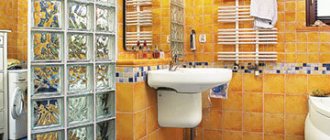In order to avoid cutting the tiles, when laying them on the floor in the toilet, the toilet bowl must first be dismantled. If a heated floor system is provided under the tiles, then further installation using fasteners that require drilling is undesirable. It is necessary to glue the toilet to the ceramic tiles. For this, certain adhesive mixtures are used.
Preparation for installation
Before installing the toilet on the tiles with your own hands, you need to carry out preparatory measures. They consist of preparing the surface and pipes. The toilet is connected to the sewer riser and to the water supply, so all the necessary lines must be connected and ready to be connected to the device. The back of the plumbing fixture is placed against the wall so that the drain is above the sewer pipe. Otherwise, liquid may stagnate in the pipe, which can lead to the appearance of an unpleasant odor.
Recommendations for using silicone sealant
In order for the completed seam to serve for a long time, it is important to follow a number of rules when working with sealant:
- maximum joint width – 5-30 mm,
- seam thickness – up to 1 cm,
- possible application depth – up to 60 mm,
- For defects that are too deep, it is worth additionally using plumbing tape.
Following the sequence of actions and advice from professionals will help you do the job efficiently with your own hands without the involvement of specialists and extra costs.
Floor-standing toilet with cistern Cersanit
It is good if the outlet of the plumbing equipment fits exactly into the sewer pipe. In this case, no adapters are required. If this is not the case, you need to prepare additional elements: plastic parts or corrugation. The latter is much easier to work with. To connect water, use a flexible hose, which is secured with a threaded connection.
The floor also needs to be prepared. The surface must be flat, without drops or protruding elements. It's very rare, but it happens. In this case, all significant roughness is rubbed down with sandpaper or carefully removed with a chisel. It's worse if the unevenness is too large. Then you will have to take care of the backing plate, which will level them. The tiles must be cleaned before work so that dirt and debris do not end up under the device.
DIY methods for installing a toilet on a tiled floor
To secure plumbing fixtures to the base, three methods are used: external or internal fastening, or glue. Each has its own disadvantages and advantages. So, the easiest way is to install the equipment on external fasteners. It's simple, fast and reliable. True, the fastenings remain visible. The installation method on the internal bracket does not have this drawback. It turns out reliable and beautiful, but the work becomes more complicated.
Fixation with dowels
The use of dowels and bolts is a fairly popular method of fixing a toilet. The method is simple and practical, but not without its drawbacks. First of all, the tiles will have to be drilled. This must be done carefully and carefully, because the slightest mistake can ruin the flooring. In addition, the use of dowels is designed more for lightweight products, and therefore it is better to use the adhesive method to fix a heavy model.
How to fix a toilet using dowels
To fix it on dowels, you should prepare everything you need:
- roulette;
- ammonia;
- pencil or marker for marking;
- a napkin or rag (preferably microfiber);
- electric drill;
- drill for it (exclusively for concrete).
Toilet fasteners
Less often, you may need a small piece of linoleum, sealant with a glue gun. Well, everything you need is at hand, so we can proceed directly to the work process.
Step 1. First, the toilet is tried on and pre-installed where it will stand. The ease of use and the ability to connect to water supply and sewer systems are assessed. You can also shake the bowl - this will help determine the levelness of the floor under the toilet.
Pre-installation of the toilet
On a note! If the product is unsteady, then before fastening it, a piece of linoleum, previously cut to the shape of the support, is placed under it. As an option, you can treat the joint with silicone sealant. Sometimes the problem is not the unevenness of the floor, but the toilet itself. If so, then you need to level the support and clean it with sandpaper.
Step 2. Next, the installation location of the device is determined more precisely, for which you will need a tape measure. Holes for future fasteners are marked.
Future holes in the floor are marked
Step 3. The product is removed, and large cross marks are made at the designated points.
Cross marks are placed
Step 4. Holes are drilled in the tiles using an electric drill. It is important to work extremely carefully so as not to damage the tiles, and also to ensure that the tool operates at low speeds.
The tiles are drilled at low speeds. Photo of the drilling process. The drill needs to be wetted in cold water from time to time.
Step 5. Next, the holes are drilled in the concrete. The speed of the electric drill should be higher or, alternatively, you can use a hammer drill instead (it is better suited for this).
Drilling concrete There will be plenty of dirt and dust after drilling
Step 6. The tile is cleaned of dirt and dust (and after drilling this “good” will be enough). Then the surface is degreased with ammonia.
Cleaned tiles
Step 7. Now you need to insert dowels into the holes that were made earlier.
Dowels are inserted into the holes
Step 8. The bolts are checked to see if they fit into the dowels properly. You can replace the fasteners with others if the ones included in the kit are of dubious quality.
The bolts included in the kit should fit properly.
Step 9. The toilet is installed. The holes in the tile must match those in the support.
Step 10. If there are no problems, the bolts are inserted into the dowels, while you should not forget about the washers - made of rubber or plastic. The bolts are tightened, but carefully, otherwise there will be a risk of damaging the bowl. After this, the caps are hidden with special plastic covers. That's it, the toilet is successfully secured to the floor with dowels!
At the end, all that remains is to tighten the bolts
How to fix a toilet with glue
This method is almost as popular as the previous one. For fixation in this case, use a special construction adhesive (you can buy it in a specialized store) or a mixture prepared with your own hands from epoxy resin. In addition, toilets are often secured with simple silicone sealant.
How to fix a toilet with glue
On a note! The method using glue is popular because it has important advantages. Let's get to know them.
- Reliability . A device fixed with glue/sealant will definitely not wobble.
- No dirt, dust . Therefore, there will be no need to clean up after the work is completed.
- Easy to install . To work, you do not need to have any serious knowledge or experience. You just need to know how to work with a glue gun.
- Safety . By attaching a toilet with glue, you do not risk damaging its bowl.
Do not forget that this method also requires some patience - it will take 12-24 hours for the glue to dry completely (which means you cannot use the toilet during this time).
Epoxy is the best adhesive for toilet bowls
To secure the plumbing fixture, prepare everything you need, namely:
- roulette;
- silicone-based sealant or glue;
- square;
- ammonia;
- marker;
- sandpaper;
- spatula (you will need a narrow one);
- a spray bottle filled with soap solution;
- a rag.
Installing a toilet: a – preparing the installation site; b – preparation of the base; c – coating the bottom of the toilet with glue; d – installation of a toilet; d – installation of the tank; e – sealing of the socket; g – connecting the tank to the water supply network; h – adjusting the water level in the tank; and - a fully installed toilet
After preparing everything you need, follow the step-by-step guide below.
Step 1. The toilet is tried on - placed on a pre-placed cardboard so as not to damage the floor covering. The convenience of the device is checked, how best to connect it to the sewer/water supply.
The toilet is being tried on
Step 2. The product is centered, for which you can take a tape measure or a corner. The distance to the walls on the right and left is indicated.
The distance is indicated on the left. The distance is indicated on the right. The toilet is centered.
Step 3. The cardboard is removed from under the toilet. The device is aligned with the walls of the room, for which you will need, as in the point above, a tape measure or a corner.
The product is re-leveled
Remember! When leveling, you need to position the tank as level as you can in a particular situation. The holes through which the tank will be connected to the bowl must be coaxial.
Step 4. The part of the bowl that will be in contact with the floor is outlined with a marker.
The contour of the support is outlined
Step 5. The edge of the support is cleaned with sandpaper or a knife. It should turn out perfectly smooth - this way the adhesion to the glue will be maximum.
The edge of the support is cleaned
On a note! Sometimes the area of the tile on which the support will be installed also needs to be sanded. But you should work carefully and not go beyond the markings, otherwise you can ruin the tiles.
Step 6. Where the toilet will be installed, the tiles are treated with ammonia to degrease. Then wipe dry with a microfiber cloth.
The tiles are degreased
Step 7. Sealant or glue is applied to the edge of the support. It is important to correctly calculate the amount of adhesive, because if there is too much of it, you can stain the tiles, and if not enough, then the attachment of the toilet to the floor will turn out to be fragile.
Glue is applied to the edge of the supportThe adhesive composition is applied
Step 8. After treatment with glue, the toilet is brought into the toilet and carefully placed in the place that was marked at the beginning of the process. It is better to do this with an assistant, so as not to stain the tiles with glue and not to install the product crookedly.
Installing a toiletIt is advisable to do everything with an assistant
Step 9. The floor around the support is sprayed with soapy water. This will ensure that any excess sealant that needs to be trimmed away will not stick to the tile.
The floor around the support is sprayed with soapy water
Step 10. A spatula is moistened in a soapy solution and used to remove any remaining adhesive.
Residues of glue are removed with a spatula. Residues of glue or sealant must be removed immediately after attaching the toilet to the floor in order to prevent the composition from drying out and staining the tiles.
Step 11. After some time - on average, 12-24 hours - the glue or other composition used to fix the toilet will dry. The product must not be used or moved during this time.
Step 12. Now, after the glue has completely dried, work can continue. It is connected to the sewer network, a tank is installed and connected to the water supply, a seat with a lid is installed, etc.
Interesting! We have already said earlier that glue suitable for fixing a toilet bowl can be made with your own hands. Take epoxy resin (20 parts are required), heat it to +50 degrees, add 7 parts of hardener and another 4 of solvent. After mixing all the components, you need to add another 40 parts of cement. After repeated mixing, you should get a homogeneous mixture, which must be used as soon as possible (after one and a half to two hours it will begin to harden and lose its original properties).
Use of adhesives
One of the most versatile methods of attaching a toilet to a tile floor is gluing. Modern industry offers a whole line of products designed for reliable fixation of plumbing fixtures. Often these are simple products that are applied immediately (liquid nails, sealants); there are also two-component compositions, the most famous of which is epoxy resin.
For those who want to achieve excellent results and are not afraid of work, we can recommend an adhesive composition based on epoxy resin, which has been used for decades. Its composition:
- 100 parts epoxy;
- 20 parts solvent;
- 35 parts hardener;
- 200 parts of cement.
First, take the resin and bring its temperature to 50 degrees in a water bath. The solvent is introduced, followed by the hardener. The mixture is stirred all the time. Cement is added last. The resulting mass has sufficient fluidity; when it hardens, it firmly fixes the mating parts.
While the glue is being prepared, you need to prepare the surfaces. To do this, simply sand the base of the toilet and the tiles with coarse sandpaper. An adhesive mass is applied to the base. The layer must be at least 4 mm, otherwise it will not be possible to completely fill possible irregularities in the tiles and the base of the bowl. Place the toilet in place, press down firmly and leave until completely hardened.
Even a novice repairman can install a toilet on tiles with his own hands.
The main thing is not to rush and not to forget that you are doing this for yourself. Just try, spend a little time and everything will work out, and another useful skill will appear in the home master’s collection of skills. Related article: How to fix a toilet cistern
Installation of a toilet using a closed method
Before starting the toilet installation procedure, it is necessary to make outlet holes that will lead to the sewer system, as well as from the water supply. Position the holes as close as possible to the plumbing fixture being installed.
All steps are similar to the previous method. The whole difference lies in the secrecy of the fastening elements. They won't be noticeable here. We string the toilet onto the fasteners and secure it with bolts through the side holes.
The decision on how to attach the toilet to the tile is up to you. But no matter which method you choose, experts advise not to tighten the bolts too tightly, as adjustments may be required when connecting to sewer and water systems.
The toilet has a heated floor. What to do?
Today, the “warm floor” system is quite common not only in toilets and bathrooms, but throughout the house. As you can already understand, if such a system exists, then you cannot drill the tiles. Why? Because the heating system will be damaged and stop functioning.
But don’t despair – there is a way out. Since you can't drill, you'll have to glue it. Only a couple of questions remain: with what and how?
Regardless of the adhesive material, the toilet bowl and tiles must be treated with sandpaper. With light hand movements we add a slight roughness to the lower plane of the sanitary element and the tile. This is a mandatory action, since when they are performed, the best contact between the floor and the toilet is observed.
Epoxy resin, silicone glue or liquid nails can be used as an adhesive material.
The mounting hole should be small
Choosing a mounting method
Here, a lot depends on the model of the toilet and the condition of the floor in the bathroom. Most models have two holes for screw mounting.
The location of these holes varies among different models and manufacturers, so when installing a product in place of a dismantled one, the position of the fasteners will not necessarily coincide.
In some cases, the holes are made so that the screws do not go through the sole of the toilet into the floor, but pass through special fasteners.
These holes can be visible from the outside, as in the photo above, or completely hidden from users' eyes. Most often, toilets with a visible lack of fastenings for installation belong to the so-called “attached” models. They are usually attached to the wall. Accordingly, the floor will not be damaged at all.
In some models, usually heavy and large, there may be four holes for fasteners - two on each side of the toilet.
Adhesives and their benefits
Gluing a toilet is easier and simpler than installing it on dowels. Using a drill can damage the tiles. Glue allows you to quickly and efficiently install plumbing fixtures with minimal financial and physical costs. There are enough options for adhesives to make a choice in favor of the most suitable composition.
Epoxy adhesive
You can buy epoxy glue ready-made in a store or prepare it yourself in strict accordance with the proportions:
- 10 parts epoxy resin;
- 20 parts cement;
- 2 parts solvent;
- 3.5 parts hardener.
The resin is heated to 50 ° C, a solvent is added to it, then a hardener and only at the end cement. The mass is thoroughly mixed and can be used within 1-2 hours. The adhesive provides a high level of adhesion strength.
Silicone
A common fastening method is silicone. Its advantage is that the subsequent dismantling of plumbing fixtures is carried out quickly and without significant effort. There will be no damage or chips on the tiles or toilet. But if you use only silicone during installation, the body of the plumbing fixtures may move during operation.
It is necessary to select a sealant that matches the specific installation option.
Liquid Nails
Liquid nails will help you cope with the task. The surface of the floor tiles and the connecting part of the plumbing fixtures are lubricated with the compound, connected and pressed against each other with force. Then the toilet is removed from the floor and placed on its side, kept for a certain amount of time indicated in the instructions on the packaging of liquid nails, after which the final installation is performed. After the nails harden, the structure will be strong and reliable.
Cement mortar
The use of cement mortar for this purpose is a rather original solution. However, there is no need to doubt the reliability of this method. When using cement mortar, the structure is firmly fixed. But this option for installing plumbing also has some disadvantages.
The main disadvantage of using cement mortar is the difficulty of dismantling the structure. If there is a need to replace the toilet, then you will literally have to sweat.
Cement mortar
Important! The peculiarity of this method is that before applying concrete to the tiles, it is necessary to make notches. This is required in order to increase the adhesion of the solution to the surface. Notches can be made using a hammer and chisel, but you should be extremely careful, as you can damage the facing material.
After applying the cement, you need to press down the toilet and wait a while. Excess cement, squeezed out under the weight of the plumbing fixture, is collected using a spatula. Complete hardening of the cement will occur after 24 hours.
Homemade composition
It can be made from available materials. At one time I used foam plastic packaging from a TV for this. I crushed the foam into a container and poured acetone into it. I used it to degrease the surface after cleaning. It is important to ensure that the mixture is thick enough and without lumps.
Glue your plumbing fixtures onto this homemade miracle and you will see that I have recommended a completely effective solution.
Some problems in the reliability of the methods I have described are associated with the relatively small surface of the plumbing fixture in contact with the tile. I can say that I once used the following:
First, the toilet was attached with anchors to a large porcelain tile, which, in turn, was glued to the floor. I used a hammer drill to cut out indentations in the floor covering for the protruding heads of the anchors. This way I achieved better stability of the structure and a larger contact area at the gluing site. The only downside to this is that it is almost impossible to completely accurately cut out the configuration of the equipment attached to the porcelain tiles. Therefore, the tiles attached to the anchors will be a kind of square platform under the plumbing and create a small protrusion. So it’s up to you to decide whether you need a more reliable fastening or whether aesthetics should come first.
Porcelain stoneware can be replaced with a moisture-resistant wood board, but, in my opinion, this is not a very durable substrate.
How and with what to glue a toilet to a tile When choosing what to use to glue a toilet to a ceramic tile, you need to use industrial glue or an adhesive for a floor-standing toilet made at home. A compact glued with this composition will stand securely, and homemade glue will not spoil the tiles.
Installation details depending on size
According to their purpose and parameters, devices are divided into universal, children's and devices with a special design for people with disabilities. Installation of the toilet, depending on the size, is simple. It is important to observe the technological parameters of the product when connecting it to sewerage and water supply. Modifications of the latter version are equipped with a wide bowl, height-adjustable and special armrests and handrails.
How to install on uneven tiles
If the floor in the bathroom is uneven, the toilet is installed as follows: it is necessary to level the floor using plastic or rubber gaskets. When installing the gasket, the gap between the floor and the toilet is removed. You can also use cement mortar on which the toilet is installed. Excess mortar extending beyond the frame is removed with a spatula.
How to screw to ceramic tiles
A toilet installed on a tiled floor, when fastened with bolts, can be easily dismantled if necessary without damaging the tiles.
At the installation site, you need to mark with a simple pencil strictly in the center of the bolt holes. At the marking site, the tiles are drilled for mounting holes for mounting bolts.
The drilled holes are cleaned of dust. Before inserting the dowels, they are filled with silicone to create waterproofing. To prevent moisture from getting under the lower edge of the frame, silicone sealant must be applied along the lower perimeter of the device during installation. Insert the bushings into the holes and tighten the mounting screws. After this, remove the protruding sealant from the tile with a rubber spatula.
Precautionary measures
It is important not only to know how to glue the toilet to the floor. We must not forget about safety precautions:
- Wear protective gloves when working.
- If glue gets on your skin, wipe the area with acetone and then rinse with tap water.
- After the plumbing fixture is installed, wash your hands with soap.
Useful tips
To properly install a toilet on a tile, there are a number of useful tips:
- Before installing plumbing, it is necessary to complete all repair and finishing work in the bathroom. This is necessary so that during the installation process there are no problems with fitting the tiles.
- Always measure the distance to the sewer pipe and surrounding walls.
- It is best for two people to install the toilet.
- If there is an uneven surface in the bathroom, then to prevent the toilet from wobbling, a backing is placed under it during installation.
- If the toilet has a heated floor, this means that drilling cannot be done. Drilling tiles with a heated floor system will lead to damage. For this purpose, only methods involving gluing the toilet to the tile are suitable.
Common Mistakes
The most common mistake is poor surface leveling. As a result, equipment breakdown and leakage may occur. To do this, you need to have a building level on hand.
Poor sealing can lead to unpleasant odors and unwanted leaks. You need to use only high-quality components with good rubberized gaskets.
There is no need to skip the point of cleaning all pipes from contamination so that the service life of the equipment is longer. If a leak in the drain barrel is detected, it is necessary to check the serviceability of the valves.
Installing a toilet is not a complicated process; you can do it yourself. The main rule is to follow all instructions and recommendations for its installation.
Preparatory work
To install a toilet on a tile base using sealant and then connect it to various communications, the following materials and tools are required:
- toilet;
- pipe (preferably corrugated);
- ball valve;
- cold water supply hose;
- sealant (any kind, as long as it is waterproof);
- sealant for connections;
- drill for glass and concrete;
- hammer drill (you can also use an impact drill);
- a set of open-end and adjustable wrenches;
- screwdrivers;
- core;
- hammer;
- pencil.
Depending on the type and characteristics of the toilet base, its installation on a tile base can be carried out using two methods: open and closed. The first type involves the protrusion of the bolts that secure this type of plumbing. The second, as is already clear, is their hidden location inside the toilet body itself. But let's take things in order.











